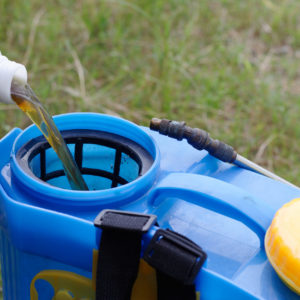Paraquat Poisoning Safety Measure Was Known To Be Ineffective, and Only Designed to Keep Dangerous Herbicide On The Market: Report

According to a new investigative report, the makers of Gramoxone and other paraquat-based herbicides have long hid safety problems linked to the weed killer from the public and health regulators worldwide, ignoring clear signs that additives designed to avoid fatal poisonings from paraquat were ineffective.
The detailed report, titled “The Paraquat Papers”, was published by Greenpeace on March 24, outlining the long history of paraquat poisonings and attempts by the manufacturers to conceal the avoidable risks, which have claimed tens of thousands of lives since the herbicide was first introduced in the 1960s.
Paraquat was originally introduced under the brand name Gramoxone in 1962, and became commercially available in the United States in 1964. Although it has been banned in a number of countries, it is still widely used throughout the U.S. to kill broadleaf weeds and grasses before planting numerous types of crops, and is sometimes sprayed on plants before harvest in order to dry them out.

PARAQUAT Parkinson's Lawsuits
Exposure to the toxic herbicide Paraquat has been linked to a risk of Parkinson's disease.
Learn More About this Lawsuit SEE IF YOU QUALIFY FOR COMPENSATIONConsuming just a single tablespoon of paraquat is usually fatal, and it has been accidentally, and intentionally, consumed thousands upon thousands of times over the decades, according to the report. The victims are often children, and it has taken a specifically high toll on lives in Asia, with Japan reaching 1,000 paraquat deaths per year in the 1980s, and other countries, such as China and Sri Lanka, seeing hundreds of deaths per year.
In fact, paraquat was eventually banned in more than 50 countries worldwide. One of the few reasons the manufacturer was able to keep the product on the market in the U.S. was the addition of an emetic; which is a chemical designed to induce vomiting if swallowed.
Although the manufacturer Syngenta has indicated this would save lives, the investigative report and one of the company’s own former scientists indicate the safety feature doesn’t work. Syngenta knew it didn’t work, and the only reason they added it was to keep making profits off a particularly deadly product, according to the documents reviewed by the investigators.
Most weed killers have a fatality rate of between 4% and 8% if swallowed, due to the toxic chemicals they contain. Considering herbicides are designed to kill other organisms, the fact that they have toxic chemicals is no surprise, and is expected. However, the fatality rate for swallowing just 10ml, one tablespoon, of paraquat is 65%.
Death by paraquat poisoning is quick and agonizing, as the body’s pulmonary system fails. And often, those that die are children.
The emetic, a chemical codenamed PP796, was supposed to help prevent many of those deaths. However, according to documents which have unsurfaced in the discovery phase of paraquat lawsuits, not only did PP796 not work, the company knew it.
One Syngenta former scientist, Jon Heylings, worked for the company for 22 years. He says he tried to ring the warning bell about the ineffectiveness of the emetic, but was rebuffed.
According to Heyling, paraquat contains too little PP796 to work as an effective emetic before the weed killer kills its victim, even for those who swallow the minimum lethal dose. Heyling indicates the concentrations used in paraquat come from a “fabricated” report done in 1976 which he says was misleading and manipulated to claim humans were 10 times more sensitive to PP796 than animal test subjects, instead of using the dosages given to animal test subjects as an accurate indicator.
Heyling brought this to the attention of Syngenta executives in 1990, he says. However, Syngenta pushed ahead, and had its concentration of PP796 declared the global standard by the Food and Agriculture Organisation of the United Nations (FAO). Now, it is the standard all paraquat-based weed killers need to meet.
Heyling again issued a warning in 2018 and urged the FAO and the U.S. Environmental Protection Agency to change that standard. It currently remains the same.
The emetic issue is also being raised in paraquat lawsuits being filed in the United States by farmers who developed Parkinson’s disease after working with the weed killer. Their attorneys say the emetic issue highlights how far Syngenta has been willing to go to keep a lid on how dangerous the side effects of paraquat really are, in order to keep the herbicide on the market and marketable.
The U.S. lawsuits allege paraquat would have been banned in the 1970s had it not been for the manufacturer’s claims the emetic would save lives.
In a response to the report, Syngenta continues to defend the safety of the toxic herbicide, suggesting that Heylings’ conclusions are not backed by science, and indicating that both the FAO and EPA have not changed their recommendations.
The company says medical experts now say increasing the levels of emetic in paraquat could make it even more toxic, not less. The company claims neither it, nor the company that initially marketed paraquat, ICI, had any intention of deceiving the public or regulators.
Paraquat Parkinson’s Disease Concerns
While still available for purchase, paraquat is subject to severe restrictions in the United States. However, warnings and safety instructions largely focus on the risk of paraquat poisoning, and lawsuits allege the manufacturers failed to adequately disclose the link between paraquat and Parkinson’s disease, which may leave users with chronic and progressive neurological injuries.
A series of studies published over the past year have found the toxic effects of Paraquat go beyond weeds, and also impact animals and humans, indicating that farmers using the herbicide may be several times more likely to develop Parkinson’s. Paraquat research has also found individuals with certain genetic variations may be 11 times more likely to develop Parkinson’s after routine exposure to the herbicide.
Parkinson’s disease affects more than 500,000 Americans, with approximately 50,000 new cases each year. The disease causes the loss of motor functions, causing imbalance and shaking, which gets progressively worse over time.
The manufacturers decision to withhold warnings about the link between paraquat and Parkinson’s has resulted in growing litigation, which has uncovered the documents at the heart of the investigative report published this week by Greenpeace.
Get more articles like this sent directly to your inbox.
"*" indicates required fields




0 Comments